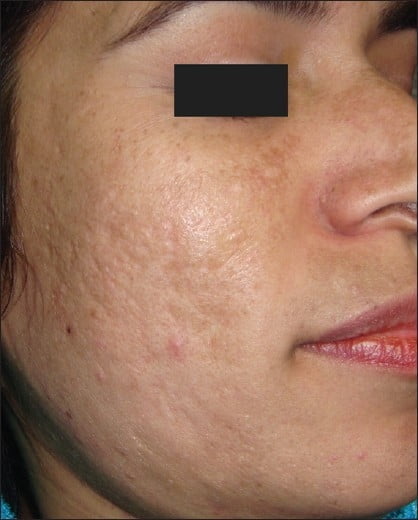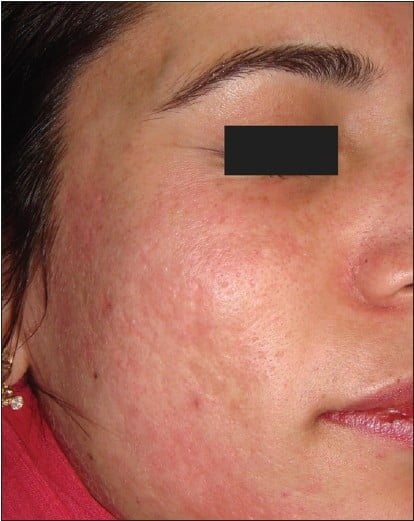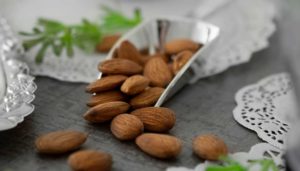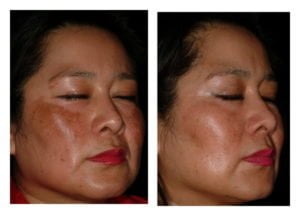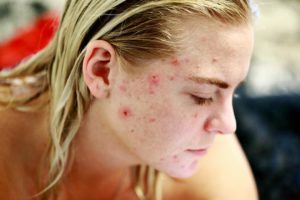Atrophic scars are a type of scar caused mainly by acne for which there are some treatments that help improve or remove them.
What are atrophic scars?
Atrophic scars are a type of scar that occur when the skin does not regenerate completely, they are characterized for leaving a small hole or some area of the skin with more depth than the rest.
These scars are mainly caused by a lack of collagen when the wound heals, or because an inflamed acne injury happens. Inflammatory gauges destroy the accumulated fat and if the size of the injury is too deep, there is an increased risk that it will not be completely filled by the tissue during the repair stage.
Atrophic scars are usually common in people who have suffered from acne, have suffered from chicken pox or have had a mole removed, and although they do not pose any health risk, they can generate a physical complex.
Types of atrophic or acne scars
Generally we can classify atrophic scars caused by acne into three groups:
- Boxcar scars: They are wide and shallow scars, which usually have a shape.
- Ice pick scars: They are deep scars but small in width, they seem like deep spots on the skin.
- Rolling scars: They are wider than boxcars since they fill a larger area, they also have an irregular shape as well as variations in depth.
Treatment of atrophic scars without surgery or cosmetic treatments
Starting with the cheapest options, there is a chance of improving atrophic scars using certain cosmetic ingredients.
It is not a highly researched area, but there are several studies reporting an improvement in the size of atrophic scars with the use of adapalene or tazarotene. There isn’t any other actives indicated for the treatment of atrophic scars.
Tazarotene
Using tazarotene 0.1% gel has been shown to help reducing the size and severity of atrophic scars.
According to a study published in early 20191 Afra TP, Razmi T M, Narang T, Dogra S, Kumar A. Topical Tazarotene Gel, 0.1%, as a Novel Treatment Approach for Atrophic Postacne Scars: A Randomized Active-Controlled Clinical Trial. JAMA Facial Plast Surg. 2019;21(2):125–132. doi:10.1001/jamafacial.2018.1404 in which 34 participants had tazarotene gel applied to 0.1% on one half of the face and microneedling was applied to the other half (1.5 mm in 4 sessions) over 3 months, 31 participants presented improvements while 3 did not.
On average, a reduction of a 3 points less severity was achieved in atrophic scars using tazarotene, whereas microneedling achieved 2.5 in 6 months.
Adapalene
Adapalene is another type of retinoid that, like tazarotene, has been shown to be effective in treating and preventing atrophic scars2Loss MJ, Leung S, Chien A, Kerrouche N, Fischer AH, Kang S. Adapalene 0.3% Gel Shows Efficacy for the Treatment of Atrophic Acne Scars. Dermatol Ther (Heidelb). 2018;8(2):245–257. doi:10.1007/s13555-018-0231-8 .
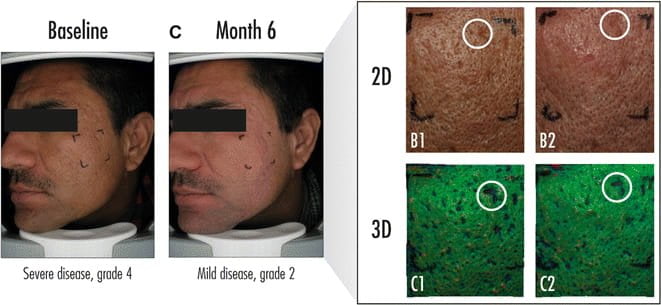
In this case, adapalene is used at a 0.3% for the treatment of atrophic scars, although adapalene has shown that a 0.1% prevents atrophic scars, it is not capable of treating them as it happens at 0,3%.
Two studies have investigated how adapalene reduces atrophic scars, in the first one mentioned above, adapalene was used at 0.3% gel once a day for 4 weeks, and twice a day for the next 20 weeks and 50-80% of all study participants noticed significant improvements in acne scars and an improvement in skin texture.
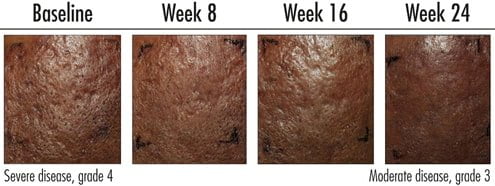
In the other study, adapalene gel 0.3% and benzoyl peroxide 2.5% were used, and during 24 weeks participants applied this gel to one side of the face and not to the other side.
The changes obtained in a study3Dréno B, Bissonnette R, Gagné-Henley A, et al. Prevention and Reduction of Atrophic Acne Scars with Adapalene 0.3%/Benzoyl Peroxide 2.5% Gel in Subjects with Moderate or Severe Facial Acne: Results of a 6-Month Randomized, Vehicle-Controlled Trial Using Intra-Individual Comparison. Am J Clin Dermatol. 2018;19(2):275–286. doi:10.1007/s40257-018-0352-y appear in the following graphic of an image cut of the study:
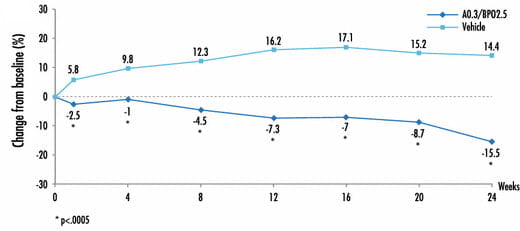
Microneedling or dermaroller
Microneedling therapy has been backed up by several studies as one of the cheapest treatments for wrinkle reduction and improvement of skin texture due to an increase of collagen production.
Microneedling is, briefly explained, a treatment whereby using a device that contains microneedles we pass it through the skin creating micro-punctures that increase the production of collagen.
In the case of acne scars, it is a treatment that is usually well tolerated and that usually gets a better response if the severity degree of atrophic scars is minor4Majid I. Microneedling therapy in atrophic facial scars: an objective assessment. J Cutan Aesthet Surg. 2009;2(1):26–30. doi:10.4103/0974-2077.53096. Despite this, it is a very effective treatment that usually gives results in all treated people.
88.7% of patients who participated in the study obtained excellent results, since the severity of the scars decreased two or more degrees in 72.2% of the patients, while the remaining 16.7% improved only one degree.
Moreover, it is concluded that it is normal to get an excellent response in rolling scars and boxcar scars, whereas in the icepick scars type it is normal to get a moderate response, although this moderate response does not mean that it is not a good option for icepick scars since it is currently one of the preferred techniques.
Professional treatments for atrophic scars
When the options mentioned above do not work or the degree of severity of atrophic scars is big, it is generally recommended to undergo with some cosmetic treatments with the help of a professional.
In the case of the microneedling mentioned above, it is recommended to go to a clinic to get it done, since it would be done in a safer way or you could have dermapen, which is a more powerful microneedling variation.
In the case of professional medical treatments we can find a greater variety than those that we can perform by ourselves in our own home.
Chemical peels
We have previously mentioned that acne scars could not improve with other topical options unless they were retinoids, this is not true at all, in fact they can also be treated with acids but not from our own home since the acids that we can acquire have very low percentages to be able to decrease them.
There are different types of acids that can be used to treat acne scars5Fabbrocini G, Annunziata MC, D’Arco V, et al. Acne scars: pathogenesis, classification and treatment. Dermatol Res Pract. 2010;2010:893080. doi:10.1155/2010/893080, among the most common acids are:
- Glycolic Acid: It is the most used acid to treat atrophic scars, it is used in concentrations ranging from 30% to 70% depending on the scars severity. The best results are achieved in 5 sessions spread every 2 weeks applying a 70% glycolic acid.
- Salicylic acid: The best results are achieved when 3 to 5 sessions are performed every 3 or 4 weeks with a 30% salicylic acid.
- TCA: Also known as Trichloroacetic acid is a type of exfoliating agent that is usually used from 10% to 35%, it is not recommended to use a higher percentage since it can cause damage to the skin and even make scars worse. It can also be applied using the CROSS technique, which generally achieves a considerable improvement in icepick scars.
- Phenolic acids: They are used on rare occasions and are capable of reaching deeper depths in the skin layers than other peels (it reaches the midreticular dermis). These acids produce a great effect in the increase of collagen. They are not usually recommended since they require anesthesia and can cause pigmentation, so they are contraindicated in skin types IV to VI.
Microdermabrasion
Microdermabrasion is a procedure that destroys damaged skin to promote re-epithelialization. This technique consists of removing the outer layer of the epidermis to speed up the exfoliation process.
This procedure does not require anesthesia and is not considered very powerful since it cannot improve deep atrophic scars and shows very little response to deep icepick or boxcars scars.
The results obtained on average when using microdermabrasion according to an study6Kravvas G, Al-Niaimi F. A systematic review of treatments for acne scarring. Part 1: Non-energy-based techniques. Scars Burn Heal. 2017;3:2059513117695312. Published 2017 Mar 30. doi:10.1177/2059513117695312 were:
| No response | Low | Moderate | Good | Very good | |
| Patients number | 3 | 5 | 2 | 1 | 0 |
The student performed a microdermabrasion session 15 minutes a week for 8 weeks. The percentage of improvement were: low (1-25%), moderate (26-50%), good (51-75%) and very good (76-100%).
Laser treatment
Laser resurfacing treatment is one of the best treatments for atrophic scars with a high percentage of satisfaction among those who have tried it, although it may not be the most indicated for icepick scars6Kravvas G, Al-Niaimi F. A systematic review of treatments for acne scarring. Part 1: Non-energy-based techniques. Scars Burn Heal. 2017;3:2059513117695312. Published 2017 Mar 30. doi:10.1177/2059513117695312.
We can find two categories for different types of lasers, both effective, among them we have:
Ablative laser
It is an invasive treatment that works by removing the outer layers of the skin, causing it to increase and to remodel collagen, producing scars reparation.
The results may appear from the first session, since reepithelialization generally begins 5 to 10 days after treatment in the case of the CO2 laser and 4 to 7 days in the case of the Er:YAG laser.
Another example would be the diode laser that promotes and remodels the synthesis of collagen with effects of improving its production that can last up to 6 months after completing the treatment.
The CO2 laser is known to produce better results than Er:YAG, although the latter requires less time to recover from treatment.
Non-ablative laser
Unlike ablative lasers, these are a less invasive procedure and they work by heating the inner layers of the skin in a way that the production of collagen is increased without affecting the outer skin layers.
This type of laser is generally safer and produces fewer side effects, although it usually requires more sessions than ablative laser to achieve better results.
For example, the Nd:YAG laser generally improves the appearance of acne scars (40-50%) if used in sessions 3-5 times a month for a few months.
Fillers or facial fillers
Facial fillers have been shown to improve atrophic scars considerably, we can classify them into 3 groups7 Wollina U, Goldman A. Fillers for the improvement in acne scars. Clin Cosmet Investig Dermatol. 2015;8:493–499. Published 2015 Sep 29. doi:10.2147/CCID.S86478 :
| Fill type | Average duration | Common examples |
| Temporary | 3-18 months | Hyaluronic acid, collagen |
| Semi-permanent | Up to 24 months | Poly-l-lactic acid y calcium hydroxylapatite |
| Permanent | Many years or a lifetime | Silicone, polyacrylamide, polymethylmethacrylate and hydroxyethylmethacrylate |
As an advantage, it can be highlighted that they have a great capacity to fill the skin tissue occupied by the atrophic scar.
The best results are obtained in rolling and boxcar scars when they are not too big, for icepick scars good results are not obtained and it is better to opt for another treatment.
Depending on the filler type, you will get better or worse tolerability, since the permanent ones could lead to a greater chance of side effects and the temporary ones last less time, the best option is to opt for a semi-permanent one.
